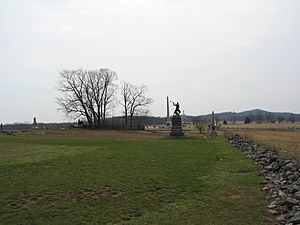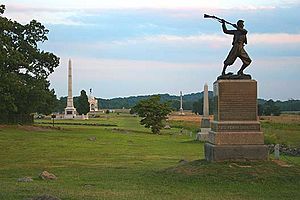High-water mark of the Confederacy facts for kids
Quick facts for kids High-water mark of the Confederacy |
|
|---|---|

To the left (east) of The Angle stone wall was the farthest advances of the units of Longstreet's assault during the 1863 Battle of Gettysburg.
|
|
| Location | Cemetery Ridge, Gettysburg National Military Park |
| Establishing event |
Pickett's Charge, July 3, 1863 |
The high-water mark of the Confederacy is a special spot on Cemetery Ridge in Gettysburg, Pennsylvania. It shows the farthest point that soldiers from the Confederate army reached during a huge attack called Pickett's Charge. This happened on July 3, 1863.
Think of it like the highest point a wave reaches on a beach. This "high-water mark" is seen as the best chance the Confederate army had to win the American Civil War. This important spot is just east of a stone wall known as "The Angle".
Contents
History of the High-Water Mark

A government historian named John B. Bachelder first used the name "high-water mark" after the war. This was when many monuments were being built on the Gettysburg Battlefield.
Many historians believe the Battle of Gettysburg was a major turning point in the war. They see this specific spot as where the Confederacy made its last big attack in the eastern part of the United States.
Pickett's Charge: The Big Attack
On the third day of the battle, July 3, 1863, General Robert E. Lee, who led the Confederate States Army, ordered a massive attack. His target was the center of the Union Army line on Cemetery Ridge.
This plan meant almost 12,500 Confederate soldiers had to march over 1,000 yards (about 914 meters) of wide-open land. This was a very dangerous move.
Before the soldiers marched, the Confederates fired many cannons. But most of these shots did not hit their targets. The long march across the open fields toward the Union lines became known as Pickett's Charge.
Major General George Pickett was one of the leaders of this attack. Even though other generals were involved, his name became famous for this brave but costly charge.
Union cannons and soldiers on Cemetery Ridge fired heavily at the advancing Confederates. About half of the Confederate soldiers were killed or wounded.
One of Pickett's brigade leaders was Brigadier General Lewis Armistead. His soldiers managed to break through the Union lines in only one place. This spot was a bend in the stone wall, now called "the Angle."
However, the Union soldiers quickly closed this gap. Any Confederate soldiers who got through were soon captured or killed. General Armistead himself was among those killed.
After the Battle
General Lee's Army of Northern Virginia left Gettysburg the next day and went back to Virginia. The war continued for almost two more years. But Lee launched very few attacks after Gettysburg, and none were as large as the Gettysburg campaign.
Monuments at the High-Water Mark
Several monuments stand at the high-water mark to remember the events of that day:
- The High Water Mark of the Rebellion Monument is a bronze tablet. It shows the exact spot where Pickett's Charge reached its farthest point.
- The 72nd Pennsylvania Infantry Monument (built in 1891) is a statue. It marks where Union soldiers, including the 72nd Pennsylvania Infantry, fought back the Confederate attack.
- The Alonzo Cushing Marker shows the place where Lieutenant Alonzo Cushing was badly wounded and died.
- The 1887 Lewis A. Armistead Marker marks the spot where Confederate General Lewis Armistead touched a Union cannon before he fell with deadly wounds. Armistead was one of about 1,500 Confederate Virginians who broke through the Union line at The Angle.
- The New York 1st Independent Artillery Memorial honors the Cowan Battery. This group of Union cannons fired on Pickett's Charge. Armistead's troops briefly captured one of their cannons.
Images for kids




